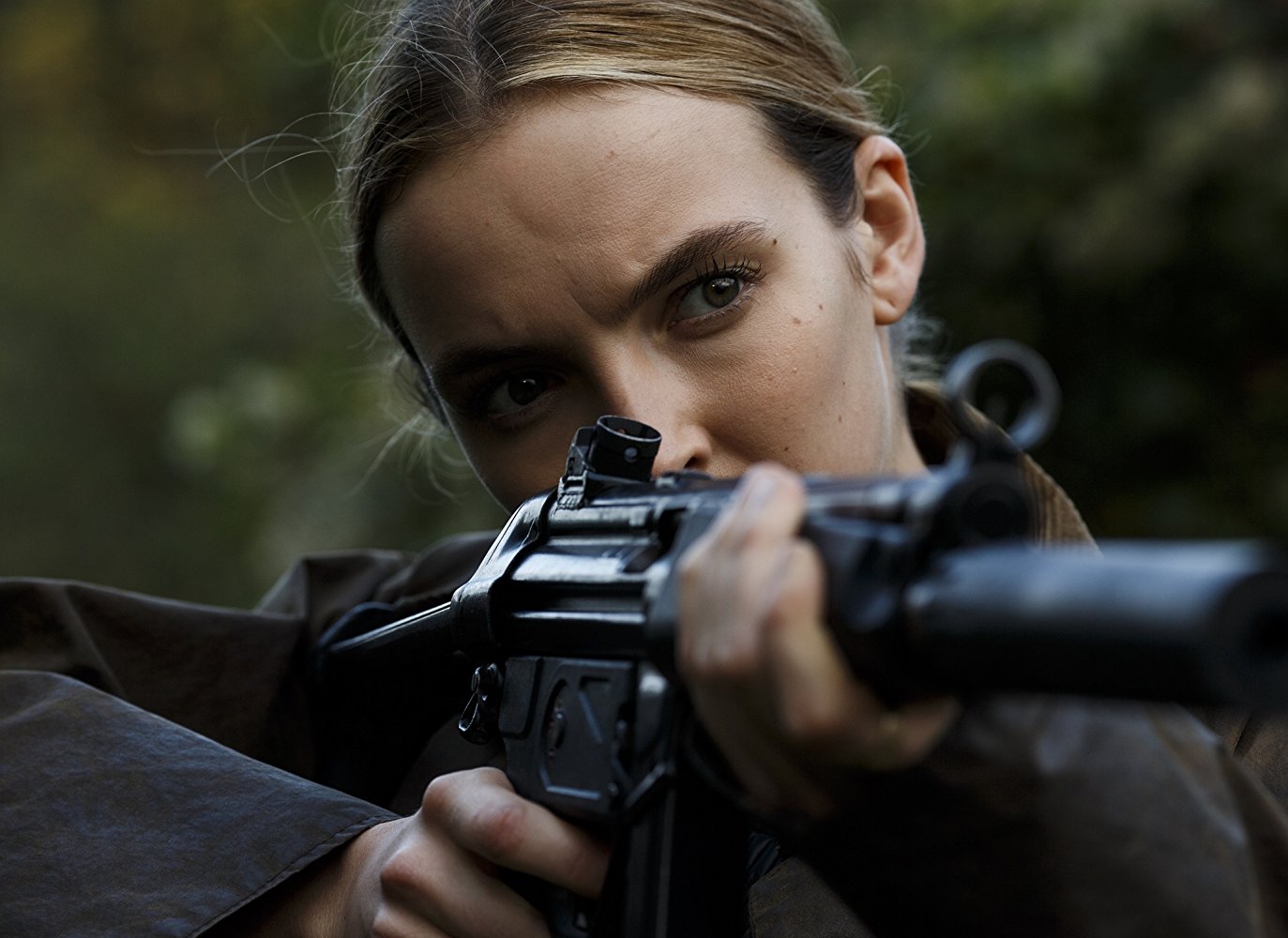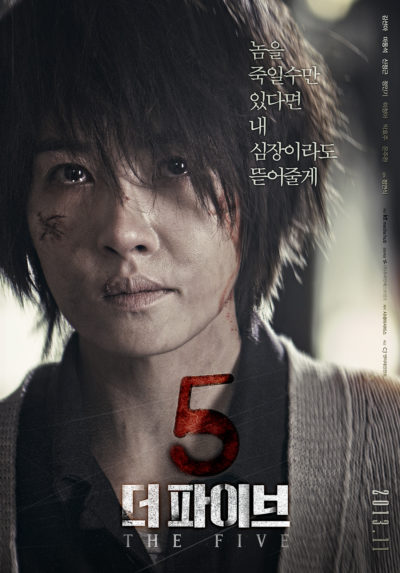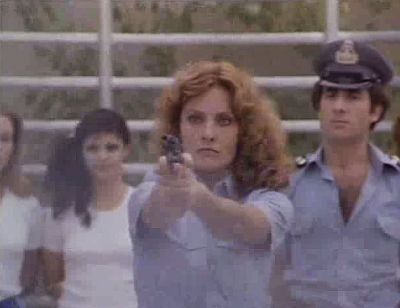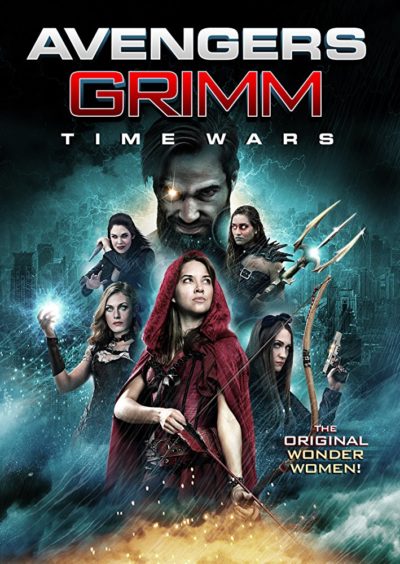 ★★★★
★★★★
“You should never call a psychopath a psychopath. It upsets them.”
 A genuinely organic hit on BBC America, this generated so much word of mouth that the ratings for this show behaved in an unexpected fashion. Including those who DVR’d the show, viewership increased for each episode over its 8-week run. That’s a rare feat these days, and is testament to the show’s unique qualities. So confident were the station in the show, that is was renewed for a second season before it had even premiered – another unusual achievement. But then, this show is arguably unlike anything else on television.
A genuinely organic hit on BBC America, this generated so much word of mouth that the ratings for this show behaved in an unexpected fashion. Including those who DVR’d the show, viewership increased for each episode over its 8-week run. That’s a rare feat these days, and is testament to the show’s unique qualities. So confident were the station in the show, that is was renewed for a second season before it had even premiered – another unusual achievement. But then, this show is arguably unlike anything else on television.
The heroine is Eve Polastri (Oh), an officer in the British intelligence service, MI-5, who believes there’s a connection between a string of assassinations across Europe. She’s right: they were all carried out be Oksana Astankova (Comer), codename “Villanelle”. Oksana is a pure, undiluted psychopath, working for a shadowy Russian organization known as “The Twelve”, under handler Konstantin Vasiliev (Bodnia). Polastri’s career is apparently ended when a witness to one of Oksana’s hits is killed in her care, and she’s fired from MI-5. However, this allows her to be recruited by Carolyn Martens (Shaw) for a off-book investigation into Villanelle.
Eve is therefore able to continue digging into Oksana’s history and activities, but the target becomes aware of the interest – signalling that knowledge by using “Eve Polastri” for her identity during a job. From here, it’s a spiral of increasingly intense cat-and-mouse, with Eve and her team tracking the assassin, while also being hunted by her. It all grows deeply personal for both Eve and Oksana, the two women developing a perverse long-distance relationship that’s more of a fixation, on both sides. Note: I’m not using “perverse” in relation to the homoerotic elements. It’s just… really bizarre. As in, “Villanelle breaking into Eve’s house, in order to have dinner with her” strange.
 The show is defiantly messy in terms of its characters, who manage both to embody the stereotypes of the dogged law-enforcement official and the slick, femme fatale, while also subverting them. From the viewpoint of this site, Oksana is likely the more interesting. As a high concept, imagine a female version of Dexter: charming and affable on the surface, yet extraordinary lethal – and capable of flicking that switch in a moment. The difference is, Villanelle has chosen not to control and direct her “dark passenger” so much as embrace them fully, and is given the chance to do so by the profession into which she is recruited. It also allows her to indulge her fondness for haute couture.
The show is defiantly messy in terms of its characters, who manage both to embody the stereotypes of the dogged law-enforcement official and the slick, femme fatale, while also subverting them. From the viewpoint of this site, Oksana is likely the more interesting. As a high concept, imagine a female version of Dexter: charming and affable on the surface, yet extraordinary lethal – and capable of flicking that switch in a moment. The difference is, Villanelle has chosen not to control and direct her “dark passenger” so much as embrace them fully, and is given the chance to do so by the profession into which she is recruited. It also allows her to indulge her fondness for haute couture.
She enjoys her work, to an almost scary degree, disdaining the simplest and most directly effective methods, too. That’d be boring, especially for such a free spirit. Why shoot, when you can kill your target by stabbing them in the eye with a hatpin instead? On the other hand, she is also incredibly manipulative. Oksana may not be able to feel any genuine emotions of her own, yet she’s supremely good at faking them, and will happily say what you want to hear, if she thinks it’ll let her use you for her own advantage. Her handler doesn’t so much control the incredibly self-confident Villanelle as unleash her in the direction of the intended target. Who inevitably ends up dead… just not necessarily quite as he would prefer.
The contrast to Eve could hardly be greater, and that perhaps goes some way to explaining the agent’s obsession: Oksana is everything Eve wants to be. Okay, except for the “psychopathic killer” bit. But that’s just a detail, right? For Eve is stuck in a rather tedious relationship, and works a job where her talents are under-used and even less appreciated. The more she learns about her target, the greater the appeal seems to be, and it works both ways: Villanelle wants “someone to watch movies with”. Or says she does anyway: this could just be another manipulative ploy, it’s impossible to be sure. Espionage, counter-espionage and assassination is a murky world at the best of times. Here? You can’t see the murk for the deceit, and at times the lies become a bit overwhelming.
After a long career expressing earnest concern on medical soap Grey’s Anatomy, Oh’s career has undergone a spectacular sea-change of late. First, there was the awesome Catfight, and now this, little if any less successful, which allows Oh to show her remarkable range of expressive… er, expressions [Seriously: you could spend an entire episode just watching her face, to the exclusion of everything else, and still be entranced]. Comer is nowhere near as well-known, but I doubt we’ll see a more memorable female character on television this year than Oksana, combining childish innocence, girlish glee and savage psychopathy. When it comes to Emmy time, it will be a travesty if at least one of them is not nominated – and ideally both. The supporting cast are no slouches either.
I will confess to being less than whelmed by the final episode which, rather than ramping up, petered out into something approaching a slumber party. Admittedly, it’s a very weird one, befitting the show, and sees Eve violate Oksana’s personal bubble of living space, partly in retaliation for the same thing happening to her earlier. But it offers no sense at all of closure: this may be a side-effect of the show having been pre-renewed. I guess there’s no point making any effort to wrap things up, when you know you’re going to be back.
Still, for 7½ episodes, this was far and away the best thing on American TV at the moment. To get one of these amazing characters in a show would have been more than acceptable. Having both in the same series provides a one-two punch of heroine and anti-heroine that’s almost unsurpassed in television history. Buffy and Faith, or Xena and Callisto, perhaps come close – although they were only story arcs. Here, Eve and Oksana are a pure, undiluted focus, and it’s glorious. The second season can’t get here soon enough.
Creator: Phoebe Waller-Bridge
Star: Sandra Oh, Jodie Comer, Fiona Shaw, Kim Bodnia





 There was a while there, where Russia dropped out of the top spot as far as being cinematic villains were concerned. No longer the “Evil Empire” of the Reagan era, they had largely been replaced, in the post 9/11 landscape, by Islamic fundamentalism. But now, those pesky Russkies are back as the bad guys once again, following their interference in the sacrosanct and solemn process of Americans electing a president. [I really must figure out a sarcasm font for this site] While this is supposedly set in the present day – I say that, because at one point, cutting-edge computer software is delivered on a set of floppy disks! – this feels more like something born out of Peak Cold War.
There was a while there, where Russia dropped out of the top spot as far as being cinematic villains were concerned. No longer the “Evil Empire” of the Reagan era, they had largely been replaced, in the post 9/11 landscape, by Islamic fundamentalism. But now, those pesky Russkies are back as the bad guys once again, following their interference in the sacrosanct and solemn process of Americans electing a president. [I really must figure out a sarcasm font for this site] While this is supposedly set in the present day – I say that, because at one point, cutting-edge computer software is delivered on a set of floppy disks! – this feels more like something born out of Peak Cold War. Not sure I’d go that far: I know it’s a great deal less
Not sure I’d go that far: I know it’s a great deal less 
 No, the main theme of the movie is the constantly shifting sands underfoot, which could easily open up at any moment and swallow the main protagonist. Some characters die during the course of the story, and it’s not necessarily the guilty ones who catch a bullet. But it’s a problem that there are hardly any sympathetic characters in the movie. Even Dominika is a big question mark, as the Russian secret service tactics force her to play a game of deception and manipulation, exactly as she was trained for. It leaves you, even at the end, guessing on which side she is/was/may have been on, in shades of Atomic Blonde. Things constantly change…
No, the main theme of the movie is the constantly shifting sands underfoot, which could easily open up at any moment and swallow the main protagonist. Some characters die during the course of the story, and it’s not necessarily the guilty ones who catch a bullet. But it’s a problem that there are hardly any sympathetic characters in the movie. Even Dominika is a big question mark, as the Russian secret service tactics force her to play a game of deception and manipulation, exactly as she was trained for. It leaves you, even at the end, guessing on which side she is/was/may have been on, in shades of Atomic Blonde. Things constantly change… I do give credit to Lawrence, who never saw an acting school from the inside, and has matured – yes, even by my standards! – into a “real actress”. I personally find it very positive that a studio is willing to make a movie almost entirely focused on its story with a nice budget ($69 million) instead of the next action-SFX-extravaganza. But I have seen better. That said, for those willing to invest the time and money, the movie may actually provide something. The actors are all good – I have not mentioned Mary Louise Parker in surprise cameo in the middle of the movie), the production design is impressive (even if Film-Russia seems to have a preference for 1970’s interior design) and the James Newton Howard (Salt, btw.) score is solid as always, even though it mainly plays in the background.
I do give credit to Lawrence, who never saw an acting school from the inside, and has matured – yes, even by my standards! – into a “real actress”. I personally find it very positive that a studio is willing to make a movie almost entirely focused on its story with a nice budget ($69 million) instead of the next action-SFX-extravaganza. But I have seen better. That said, for those willing to invest the time and money, the movie may actually provide something. The actors are all good – I have not mentioned Mary Louise Parker in surprise cameo in the middle of the movie), the production design is impressive (even if Film-Russia seems to have a preference for 1970’s interior design) and the James Newton Howard (Salt, btw.) score is solid as always, even though it mainly plays in the background. A chance encounter in a convenience store destroys the life of Go Eun-ah (Kim). For her young daughter accidentally sees serial killer Oh Jae-wook (On) abducting his next victim. Realizing he has been spotted, Jae-wook carries out a brutal home invasion, killing both the daughter and Eun-ah’s husband, and leaving her permanently paralyzed. But he has reckoned without Eun-ah’s fortitude. She devotes the rest of her life to tracking down her attacker, and puts together a team of four to help her. All need transplants, for them or their family. So Eun-ah has promised that once Jae-wook has been captured, delivered to her and killed, she will give them her organs. Damn. That’s what I call “fully committed”… But when Jae-Wook realizes he is being hunted, he turns his attentions on the hunters.
A chance encounter in a convenience store destroys the life of Go Eun-ah (Kim). For her young daughter accidentally sees serial killer Oh Jae-wook (On) abducting his next victim. Realizing he has been spotted, Jae-wook carries out a brutal home invasion, killing both the daughter and Eun-ah’s husband, and leaving her permanently paralyzed. But he has reckoned without Eun-ah’s fortitude. She devotes the rest of her life to tracking down her attacker, and puts together a team of four to help her. All need transplants, for them or their family. So Eun-ah has promised that once Jae-wook has been captured, delivered to her and killed, she will give them her organs. Damn. That’s what I call “fully committed”… But when Jae-Wook realizes he is being hunted, he turns his attentions on the hunters.
 For a film lauded for its supposed up-ending of the male gaze, this feels a bit odd, since it could be read as the sexual assault triggering Jen’s blossoming: rape as psychological therapy. She should thank her attackers! [The image of a rising phoenix branded into her skin, due to her impromptu first-aid, is not exactly subtle in its imagery. Then again, the entire film is not exactly subtle, and proudly defiant as such] If that reading is on shaky ground, it’s also amusing to note Revenge utterly fails the dreaded Bechdel Test, despite being brutally empowering, to a degree rarely seen. More evidence – as if it were really needed – of how shitty the Bechdel Test is at evaluating films.
For a film lauded for its supposed up-ending of the male gaze, this feels a bit odd, since it could be read as the sexual assault triggering Jen’s blossoming: rape as psychological therapy. She should thank her attackers! [The image of a rising phoenix branded into her skin, due to her impromptu first-aid, is not exactly subtle in its imagery. Then again, the entire film is not exactly subtle, and proudly defiant as such] If that reading is on shaky ground, it’s also amusing to note Revenge utterly fails the dreaded Bechdel Test, despite being brutally empowering, to a degree rarely seen. More evidence – as if it were really needed – of how shitty the Bechdel Test is at evaluating films. I’ve come to the conclusion I prefer bad films to bad books. A bad film can be appreciated and offer entertainment in unexpected ways. I’ve rarely found that to be the case with literature, which just… lies there, dully. If a movie sucks, then you can at least allow it to drift into the background, while you check your phone, play with the cat, or do household chores. A bad book, on the other hand, requires every bit as much effort as a good one: the return on that investment is just a great deal less.
I’ve come to the conclusion I prefer bad films to bad books. A bad film can be appreciated and offer entertainment in unexpected ways. I’ve rarely found that to be the case with literature, which just… lies there, dully. If a movie sucks, then you can at least allow it to drift into the background, while you check your phone, play with the cat, or do household chores. A bad book, on the other hand, requires every bit as much effort as a good one: the return on that investment is just a great deal less. Released in 1980, it was only the previous year – as an opening caption tells us – that women were allowed into the Greek police force. So this obscurity [hence the low-quality images, for which I apologize!] was perhaps the first Hellenic entry in our genre. The heroine is Daisy Alexiou (Karlatou, best-known for playing Prince’s mother in Purple Rain), one of the first batch of policewomen, whom we first see in an introductory training montage. Initially assigned to traffic duty, her role in chasing and capturing a bank robber quickly gets her assigned to narcotics. Which is fine with her: she has a strong anti-drug streak, due to the personal impact it has had on her, proclaiming, “It is a disgusting disease, that kills people and rots their society.” Given this, I was wryly amused to see Daisy smokes like a chimney. Hey, it was the eighties…
Released in 1980, it was only the previous year – as an opening caption tells us – that women were allowed into the Greek police force. So this obscurity [hence the low-quality images, for which I apologize!] was perhaps the first Hellenic entry in our genre. The heroine is Daisy Alexiou (Karlatou, best-known for playing Prince’s mother in Purple Rain), one of the first batch of policewomen, whom we first see in an introductory training montage. Initially assigned to traffic duty, her role in chasing and capturing a bank robber quickly gets her assigned to narcotics. Which is fine with her: she has a strong anti-drug streak, due to the personal impact it has had on her, proclaiming, “It is a disgusting disease, that kills people and rots their society.” Given this, I was wryly amused to see Daisy smokes like a chimney. Hey, it was the eighties… Considering this is nearer four decades old than three, it has stood the test of time surprisingly well. Alexiou doesn’t mess around, happily hurtling into danger without a second thought, and proves generally competent, save for an ill-advised undercover operation, which ends badly and seems to exist largely so we can see Karlatou dressed as a hooker. Outside of the cigarette use (so rampant it feels like Marlboro were one of the producers), the most dated thing here is probably Daisy and Markos having a romantic relationship, in total violation of every boss-subordinate protocol. But both the story and characters still feel reasonably contemporary, and Karlatou carries herself effectively.
Considering this is nearer four decades old than three, it has stood the test of time surprisingly well. Alexiou doesn’t mess around, happily hurtling into danger without a second thought, and proves generally competent, save for an ill-advised undercover operation, which ends badly and seems to exist largely so we can see Karlatou dressed as a hooker. Outside of the cigarette use (so rampant it feels like Marlboro were one of the producers), the most dated thing here is probably Daisy and Markos having a romantic relationship, in total violation of every boss-subordinate protocol. But both the story and characters still feel reasonably contemporary, and Karlatou carries herself effectively. I was one of the few who didn’t mind
I was one of the few who didn’t mind  Three millennia previously, the Terrans landed on the planet of Ogun, and took it over. The native Iliri, though in many ways superior to the new arrivals in both mental and physical ability, ended up subjugated. They are now very definitely second-class citizens, only remembering vague legends of their once-proud past. One such is Salryc Luxx, a rare pure-bred Iliri who is a private in the army. Despite the fierce prejudice against “her kind”, she gets a try-out for the Black Blades, the military’s elite special forces. Which, it turns out, is a haven for Iliri and their supporters. Sal becomes the first woman in the unit, and her talents – including the ability to shape shift – quickly become an essential part of the team, allowing her to become one of their top covert assassins. However, her presence also causes significant static, not least her relationship with the Black Blades’ commanding officer, Blaec.
Three millennia previously, the Terrans landed on the planet of Ogun, and took it over. The native Iliri, though in many ways superior to the new arrivals in both mental and physical ability, ended up subjugated. They are now very definitely second-class citizens, only remembering vague legends of their once-proud past. One such is Salryc Luxx, a rare pure-bred Iliri who is a private in the army. Despite the fierce prejudice against “her kind”, she gets a try-out for the Black Blades, the military’s elite special forces. Which, it turns out, is a haven for Iliri and their supporters. Sal becomes the first woman in the unit, and her talents – including the ability to shape shift – quickly become an essential part of the team, allowing her to become one of their top covert assassins. However, her presence also causes significant static, not least her relationship with the Black Blades’ commanding officer, Blaec. It’s hard to believe a film rated two stars exceeded expectations, but when I saw this had scored just 1.7 out of ten on the IMDb, I was braced for something much worse. I mean, cross off the friends of the cast and crew who scored it a “10”, and 72% of voters have given it the lowest mark possible. Make no mistake, this isn’t great. It’s not even good. But this is not quite as irredeemably bad as that score would imply.
It’s hard to believe a film rated two stars exceeded expectations, but when I saw this had scored just 1.7 out of ten on the IMDb, I was braced for something much worse. I mean, cross off the friends of the cast and crew who scored it a “10”, and 72% of voters have given it the lowest mark possible. Make no mistake, this isn’t great. It’s not even good. But this is not quite as irredeemably bad as that score would imply.